| Click On Image For Full Size |
Size | Image Description | Source | |
|---|---|---|---|---|
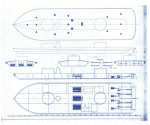 |
112k | This drawing of the Milwaukee class was submitted to the Navy department by James B. Eads as part of a proposal for warship construction. The ships generally followed this drawing as completed. However, one boiler was added in the middle pair and the pilothouse aft of the forward turret, designed by Eads as a truncated cone, was substantially altered. | Photo & text courtesy of "Monitors of the U.S. Navy, 1861-1937", pg 38, by Lt. Richard H. Webber, USNR-R. (LOC) Library of Congress, Catalog Card No. 77-603596. | |
 |
70k | Primitive sketch of the Winnebago reproduced as a photograph by T. Lilienthal, New Orleans, circa 1864-65. | Courtesy of the Philibrick Collection, Kittery, Maine. USNHC photo # NH 42391. | |
 |
145k | "The Siege of Mobile--Wreck of the Osage and the Monitor Milwaukee." Line engraving published in "Harper's Weekly", 29 April 1865, depicting Osage striking a mine and sinking near Spanish Fort on 29 March 1865. The wreck of Milwaukee, which had been sunk by a mine on the previous day, is in the center middle distance. The twin-turret monitors at right are two of the following: Winnebago, Chickasaw and Kickapoo. Ships in the right distance are "Double-Ender" and "Tinclad" gunboats also engaged in attacking the Confederate-held Spanish Fort. | U.S. Naval Historical Center Photograph # NH 59155. | |
 |
81k | "Battle of Mobile Bay ... Passing Fort Morgan and the Torpedoes". Print after an artwork by J.O. Davidson, 1886, depicting the Union and Confederate squadrons at the moment that Tecumseh sank after striking a mine ("torpedo"). Confederate ships (left foreground) are Morgan, Gaines and Tennessee. Union monitors visible astern of Tecumseh are Manhattan and Winnebago. Brooklyn is leading the outer line of Union warships, immediately followed by Hartford. | Courtesy of President Franklin D. Roosevelt, 1936. U.S. Naval Historical Center Photograph. USNHC # NH 42396. |
|
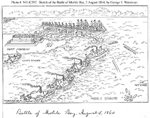 |
105k | "Battle of Mobile Bay, 5 August 1864". Reproduction of an 1864 pen & ink drawing by George S. Waterman, C.S.N., depicting the action as seen from above and inside the entrance to Mobile Bay. Confederate ships present are (as identified on the drawing): Selma, Morgan, Gaines (shown twice, in the battle line, and beached off Fort Morgan after the battle) and Tennessee. Union monitors shown are (from the front of the line): Tecumseh (sinking after striking a mine), Manhattan, Winnebago and Chickasaw. The leading two steam sloops in the Union line are Brooklyn and Hartford. Small diagram in the lower right represents the various efforts by Union ships to ram the Tennessee later in the action. | Courtesy of President Franklin D. Roosevelt, 1936. U.S. Naval Historical Center Photograph. USNHC # NH 42392. |
|
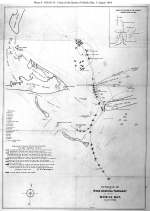 |
277k | "Entrance of Rear Admiral Farragut in to Mobile Bay. 5 August 1864". Chart of the action, prepared by RAdm. D.G. Farragut, Washington, D.C., 1st March 1865. "Explanation of Diagram from the five stand points of the Mobile fight." (printed in the lower left): "No.1. Ships lashed together and running in from Sea, and the monitors running out of "Monitor Bay" to take their station inside or eastward of the line." "No.2. Running up the channel in line of battle, and engaging 'Fort Morgan' leading ship Brooklyn encounters what she supposes to be 'torpedoes' monitor 'Tecumseh' is struck by one and sinks; Brooklyn backs astern causing confusion; Flag Ship takes the lead and passes up and engages the ram Tennessee and the gun boats of the enemy." "No.3. Running fight with the enemy's fleet which ends in the capture of one, destruction of another, and the ram and one gun boat take shelter again under Fort Morgan." "No.4. Fleet passes up and are in the act of anchoring when the ram Tennessee is seen coming out to attack them" "No.5. Shows the manner the attack was made by the fleet upon the ram by ramming her in succession and keeping up a constant fire upon her at the same time." "The points of contact are shown by the sketch in the north east corner of the plate." "De Kraft's flotilla bombarding Fort Powell." (in upper left of the chart). Ships are (as numbered in "Reference" list at left): 1. Tecumseh; 2. Manhattan; 3. Winnebago; 4. Chickasaw; 5. Brooklyn; 6. Octorara; 7. Hartford, Flag Ship; 8. Metacomet; 9. Richmond; 10. Port Royal; 11. Lackawanna; 12. Seminole; 13. Admiral's barge Loyal; 14. Monongahela; 15. Kennebec; 16. Ossipee; 17. Itaska; 18. Oneida; 19. Galena. | Courtesy of the Naval Historical Foundation. U.S. Naval Historical Center Photograph. USNHC # NH 83136. |
|
 |
109k | Mobile Bay Campaign, August 1864. Line engraving published in "Harper's Weekly", 17 September 1864. Entitled "Admiral Farragut's Fleet Bombarding Fort Morgan, 22 August 1864", it depicts the following U.S. Navy ships (from left to right): Lackawanna, Manhattan, Octorara, Brooklyn, Winnebago and Richmond. Fort Morgan is shown in the right center distance, and a battery is at the far left. | U.S. Naval Historical Center Photograph. USNHC # NH 59150. | |
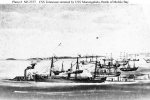 |
77k | Battle of Mobile Bay, 5 August 1864. Monongahela rams Tennessee as other Union warships move into position to engage. The two twin-turret monitors depicted at the right are Winnebago and Chickasaw. Civil War vintage artwork, photographed by T. Lilienthal, New Orleans, Louisiana. | Courtesy of the Philibrick Collection, Kittery, Maine. USNHC photo # NH 2377. |
|
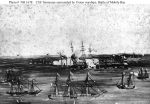 |
97k | Battle of Mobile Bay, 5 August 1864. Tennessee surrounded by Union warships, near the end of the battle. The two twin-turret monitors depicted off her bow and stern are Winnebago and Chickasaw. Civil War vintage artwork, photographed by T. Lilienthal, New Orleans, Louisiana. | Courtesy of the Philibrick Collection, Kittery, Maine. USNHC photo # NH 1678. |
|
 |
68k | Battle of Mobile Bay, 5 August 1864. Oil on canvas (40" x 66") by Xanthus Smith (1839-1929), signed and dated by the artist, 1890. It depicts the surrender of Tennessee to the Union squadron commanded by Rear Admiral David G. Farragut. Identifiable U.S. Navy ships present include: Winnebago (monitor in the left distance), Chickasaw(monitor in the foreground) and Hartford (Farragut's flagship, in the right center, painted light gray). |
Courtesy of the U.S. Naval Academy Museum, Annapolis, Maryland. Gift of Henry Huddleston Rogers, 1930. USNHC photo # KN-843. |
|
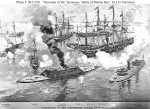 |
179k | Battle of Mobile Bay, 5 August 1864. Line engraving after an artwork by J.O. Davidson, published in "Battles and Leaders of the Civil War", Volume 4, page 378. Entitled "Surrender of the Tennessee,' Battle of Mobile Bay", it depicts Tennessee in the center foreground, surrounded by the Union warships (from left to right): Lackawanna, Winnebago, Ossipee, Brooklyn, Itasca, Richmond, Hartford and Chickasaw. Fort Morgan is shown in the right distance. | Courtesy of the U.S. Naval Academy Museum, Annapolis, Maryland. Gift of Henry Huddleston Rogers, 1930. USNHC photo # NH 1276. |
|
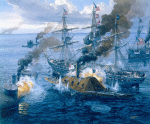 |
171k | Oil on canvas painting by the artist Tom Freeman entitled "Point Blank". The Battle of Mobile Bay, 5 August 1864. The Confederate ironclad Tennessee does considerable damage to the Oneida. In the foreground, the dual turreted monitor Chickasaw blasts away at the Tennessee. In the left rear, the monitor Winnebago rushes to give aid. | Photo and partial text courtesy of oldgloryprints.com |
|
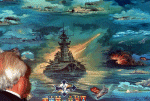 | 376k | A guest studies a painting depicting the history of battleships. The artwork was painted by George Skybeck and presented to the Pearl Harbor Survivors Association during their annual banquet at Honolulu, Hawaii, on 8 December 1991. | USN photo # DN-SC-92-05391, by PHC Carolyn Harris, from the Department of Defense Still Media Collection, courtesy of dodmedia.osd.mil. | |
USS WINNEBAGO History
View This Vessels DANFS History Entry
(Located On The Hazegray & Underway Web Site, This Is The Main Archive For The DANFS Online Project.)
Crew Contact And Reunion Information
Not Applicable To This Ship
Additional Resources
Hazegray & Underway Battleship Pages By Andrew Toppan.
Monitor National Marine Santuary, NOAA.
Tour the Wreck of the Monitor.
| Back To The Main Photo Index | Back To The Battleship Photo Index Page |
This page is created and maintained by Michael Mohl
All Pages © 1996 - 2025, by Paul R. Yarnall NavSource Naval History. All Rights Reserved.